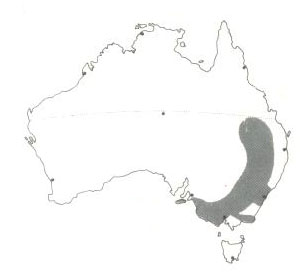![]()
 |
 |
DISTRIBUTION: Open grassland with scattered timber in south-eastern Australia. |
Diamond Firetail |
Distribution Map |
|
IDENTIFICATION. LENGTH = 120 mm MALE: Head gery; back and wings ash-brown; rump and upper tail-coverts crimson; tail black. Lores black; face, throat,lower breast, belly and undertail-coverts white; black band across upper breast, extending back along flanks where white spots occur on upper margin. Eye res; bill red with blue-tinged base; legs dark grey. FEMALE: Similar to a male but lores brown; breast band narrower. IMMATURES: Mainly olive-brown; rump and upper tail-coverts crimson; eye red-brown; bill grey-black.
|
NESTING. Breeds August-January. Nest flask-shapedwith bulky spherical nestchamber and entrance tunnel of variable length, 240-300 mm long, 100-200 mm high and 120-170 mm wide. Made of long grass blades and stems, lined with fine grass stems and white feathers; placed in thick foliage in tree or shrub. Eggs: four to seven; pure white; 18 13 mm.
|
|
FORMS. There is only the one form of the Diamond Firetail. |
|
AVIARY BREEDING. NESTING TYPES: I FEEDING: A general finch mix is ideal for this bird. Birds will also readily take seeding grasses and live food. However I have had seen these birds breed successfully with just a mixed seed diet. Egg and biscuit will also be taken readily. SPECIAL REQUIREMENTS: There are no special requirements for this species.
|
| AVIARY SPECIFICATIONS. | WIRE MESH: 1/4 x 1/4 or 6 mm x 6 mm | Also known as mouse wire |
| LENGTH: 11ft 6in or 3575 mm | WIDTH:6ft or 1800 mm | HEIGHT: 8ft or 2400 mm |
| SHED: Half the aviary should be enclosed.
These are recommendations only and individual breeders may have different dimensions and specifications.
|
FLOOR: I have found a dirt floor preferable. |
OTHER: |
|
BREEDER SUBMISSIONS. |
|
| From |
![]()
Author
P Campbell
Copyright © 2002 P. Campbell. All rights reserved.
Revised: April 20, 2002
.